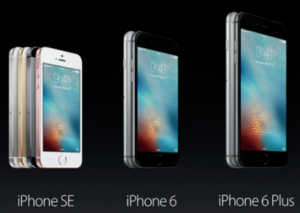Apple’s newest iPhone SE turns to a “Back to the Future” display size that validates (at least in principle) Steve Job’s mandate of keeping the phone’s physical size to fit well within the palm of the hand. Apple acknowledged this today in their on-campus event when it stated that last year it sold 30 million of these 4″ diagonal screen size units, despite the availability of the larger, more feature-rich flagship 6S and 6S Plus models.

Now the company said it will upgrade its 5-series models into a new SE version that ushers in its latest 4K video camera plus Apple Pay services into the smaller (handier) platform.
That’s not to say the move to a larger display for Apple was a mistake. On the contrary, the company moved perhaps a bit too slowly in providing Source: Apple the market with the larger displays made available with the launch of the iPhone 6 and 6 Plus (4.7″ and 5.5″-diagonal respectively) in September 2014.
Apple kept its smaller 4″ display for two years (almost a lifetime in the fast-paced smartphone market) from the time the 5-series launched in September 2012. This gave Samsung and other Android-based models a large display competitive advantage for a time. Many customers found it quite helpful in viewing the web, streaming video and doing social media with the larger (easier to read and navigate) touch displays. The problem is that the larger form factor is simply not as comfortable to hold, and its ultra-thin design and smooth edges makes it easy to drop. Interestingly, the very first iPhone 6 sold in Perth, Australia, was dropped (albeit from clumsy handling) while being shown to the press by Apple’s first customer. One Piper Jaffray analyst survey in December 2015 (reported in WSJ on Monday) found 20% of US consumers preferred the 4″ size. The paper also reports Apple should see a 10M to 15M-unit boost to annual sales from the new iPhone SE upgrade offering.
For the iPhone SE, few details were released today on the display specifics, so we will have to wait for an in-depth evaluation or side-by-side shoot-out for more visibility. Beyond the display, Apple’s upgrade to the 64-bit A9 processor along with the M9 motion coprocessor brings a suite of new services including Apple Pay to the smaller footprint phone. This brings virtually all phone sizes to technology parity with
- “Hey Siri” (always on state),
- a better battery life,
- better radios including Bluetooth 4.2,
- faster Wi-Fi (with Wi-Fi calling) and
- LTE (that supports voice over LTE),
- a new 12MP camera and
- support for Retina Flash,
- Live (animated) photo’s plus
- 4K video and 1080p up to 60 fps, and
- Slo-mo up to 240 fps.
So with 30 million 4″ iPhones sold last year alone, we see the the iPhone SE as a smart move by Apple. It offers the market a long awaited upgrade path to a very popular 4″ device that hasn’t seen an upgrade since 2013. This size category brings a new set of powerful features and services to this well established market base, and Apple can continue to leverage these alternative revenue streams as the company faces declining device sales in the maturing smartphone category. – Steve Sechrist

